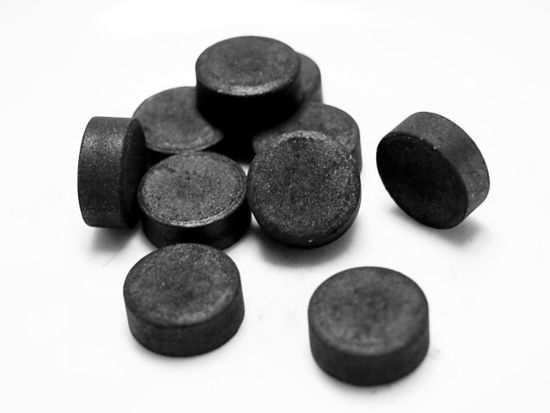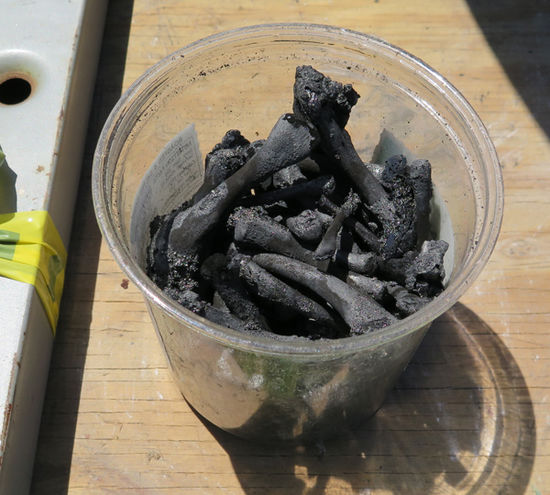Bone Char: Difference between revisions
m (+ link fix) |
mNo edit summary |
||
| (4 intermediate revisions by the same user not shown) | |||
| Line 1: | Line 1: | ||
[[File:BoneChar.jpg | | [[File:BoneChar.jpg |550px|thumb|right|A few pills of bone char.]] | ||
[ | [[File:ChickenBoneChar.jpg |550px|thumb|right|Bone Char made from chicken bones.]] | ||
== | [https://en.wikipedia.org/wiki/Bone_char Bone char] is a very effective water filter that removes many heavy metals, chlorine, fluoride and other contaminants from water. It is also used in [https://en.wikipedia.org/wiki/Bone_char#Sugar_refining sugar refining] and as a [https://en.wikipedia.org/wiki/Bone_char#Black_pigment black pigment]. It is mostly made from cow bones. The production process is similar to [[biochar]] but it contains only 10% carbon. It often has a very high phosphate content of 80%. | ||
Bone char may also be an intermediate step of processing bones for agriculture. Thick bones such as skulls are very difficult to compost. Charring them makes them brittle, and they can then put through a [[Biochar Crusher|crusher]]. The material | |||
==Use as fertilizer== | |||
Being rich in phosphorus (P), calcium (Ca) and magnesium (Mg), bone char may be a good fertilizer. Not much is known about this use, and the results have been inconsistent under different conditions. | |||
==As a way to process bones== | |||
Bone char may also be an intermediate step of processing bones for agriculture. Thick bones such as skulls are very difficult to compost. Charring them makes them brittle, and they can then put through a [[Biochar Crusher|crusher]]. The material is then much easier to compost. The video below shows how bone char could have a role in local food systems. It even shows the possibility of combining it with [[Compost Tea|compost tea]]. | |||
*The Biochar Journal: [https://www.biochar-journal.org/en/ct/70-Bone-Char-made-in-Central-Park-New-York "Bone Char made in Central Park, New York"] | *The Biochar Journal: [https://www.biochar-journal.org/en/ct/70-Bone-Char-made-in-Central-Park-New-York "Bone Char made in Central Park, New York"] | ||
== | ==Video== | ||
<html> | <html> | ||
<iframe width="560" height="315" src="https://www.youtube.com/embed/Dnbv-4BiGH8" frameborder="0" allowfullscreen></iframe> | <iframe width="560" height="315" src="https://www.youtube.com/embed/Dnbv-4BiGH8" frameborder="0" allowfullscreen></iframe> | ||
| Line 18: | Line 23: | ||
[[Category:Materials]] | [[Category:Materials]] | ||
[[Category:Food and Agriculture]] | [[Category:Food and Agriculture]] | ||
[[Category:Biochar]] | |||
Latest revision as of 22:04, 4 June 2017
Bone char is a very effective water filter that removes many heavy metals, chlorine, fluoride and other contaminants from water. It is also used in sugar refining and as a black pigment. It is mostly made from cow bones. The production process is similar to biochar but it contains only 10% carbon. It often has a very high phosphate content of 80%.
Use as fertilizer
Being rich in phosphorus (P), calcium (Ca) and magnesium (Mg), bone char may be a good fertilizer. Not much is known about this use, and the results have been inconsistent under different conditions.
As a way to process bones
Bone char may also be an intermediate step of processing bones for agriculture. Thick bones such as skulls are very difficult to compost. Charring them makes them brittle, and they can then put through a crusher. The material is then much easier to compost. The video below shows how bone char could have a role in local food systems. It even shows the possibility of combining it with compost tea.
- The Biochar Journal: "Bone Char made in Central Park, New York"
Video

